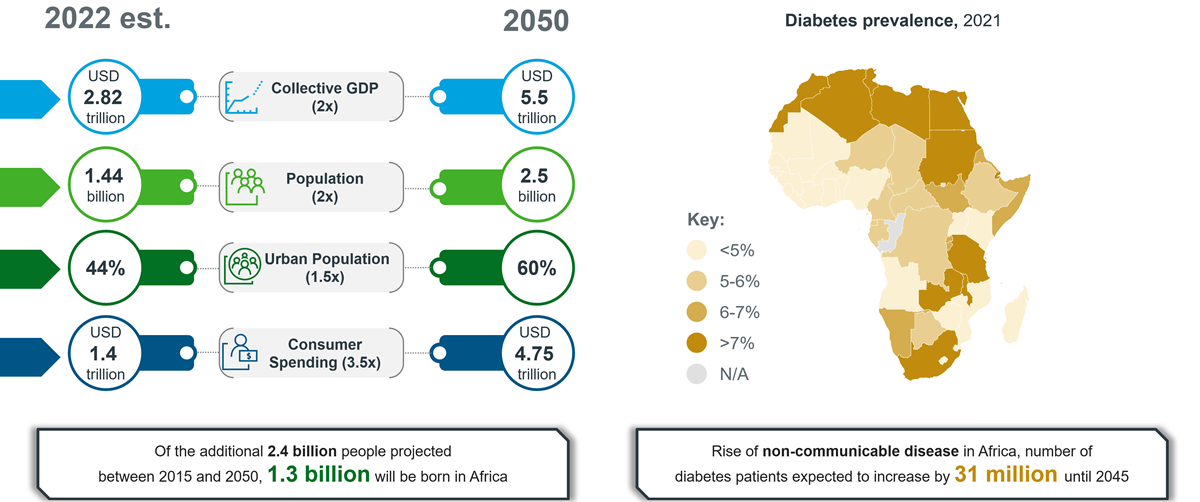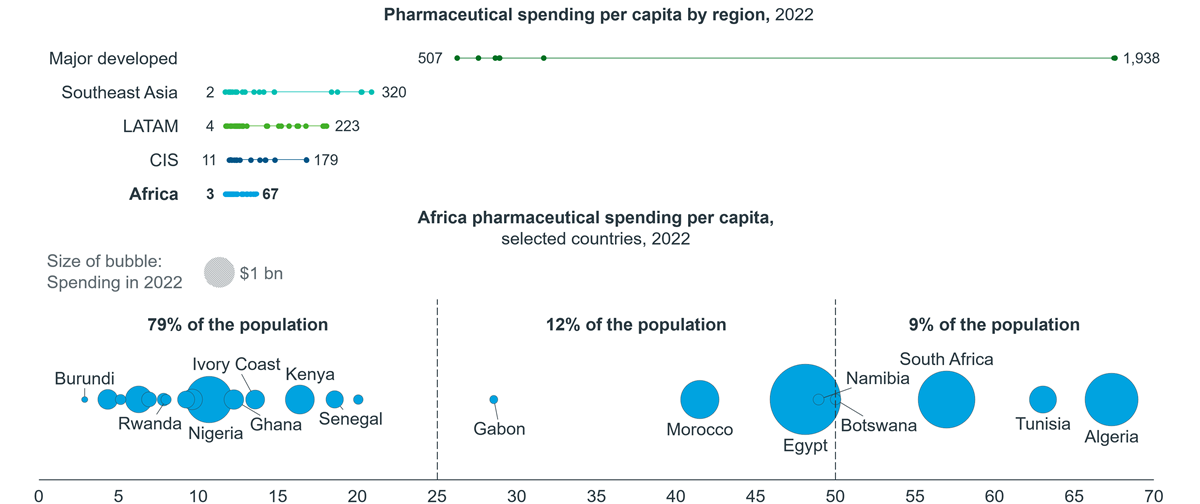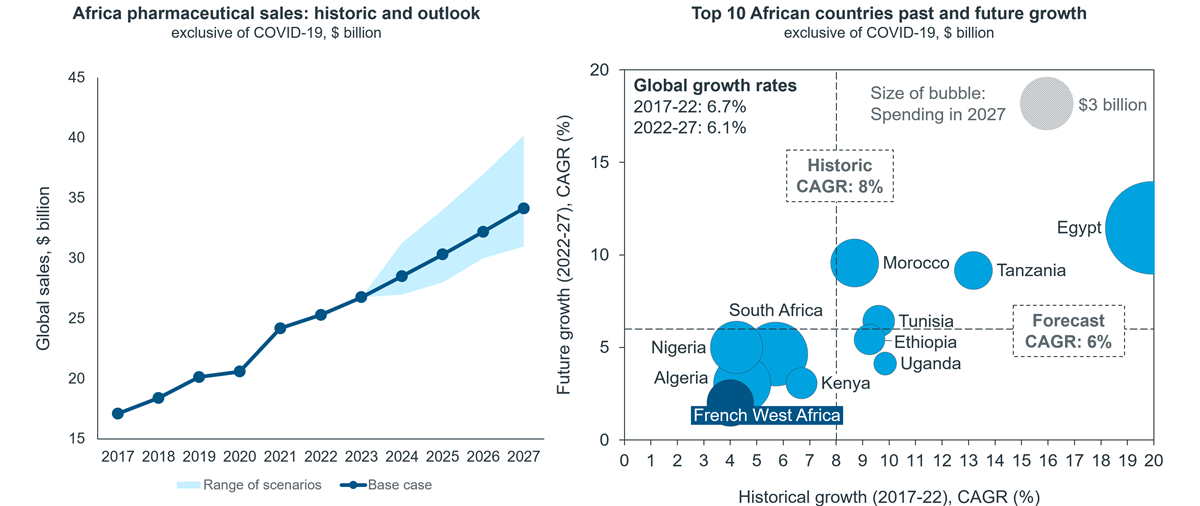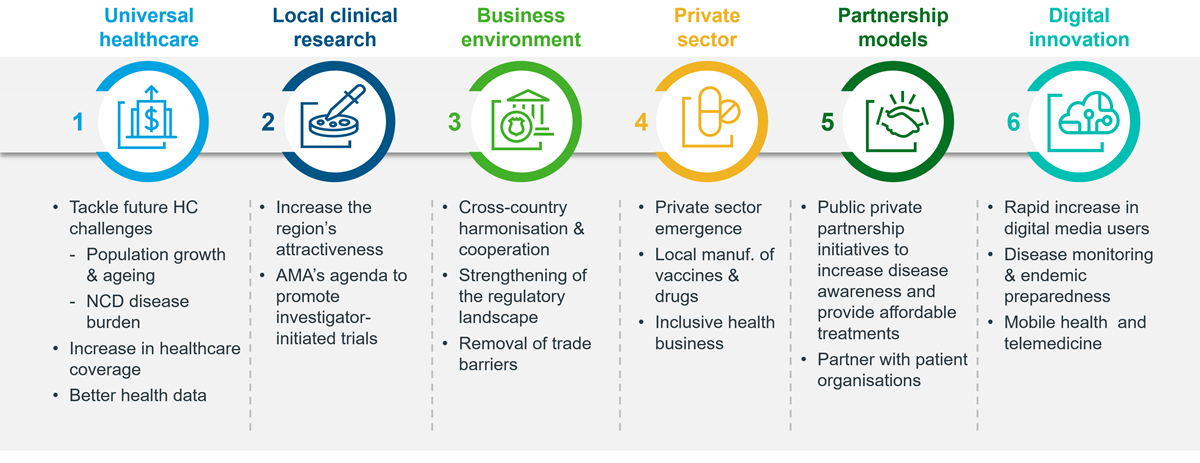





















There have been false dawns in the past for African countries and indeed the wider set of pharmerging markets, as market potential driven by demographic opportunity has not been met, with the only real exception being China.
Whilst the African opportunity is across 54 very diverse countries, there’s reason to believe this chapter will be different. First, pharmaceutical market value growth in the established markets stagnates. The pendulum is finally swinging back on the logic that tiny shares of the world’s population (the US is only 5%) should account for an ever-increasing majority of global medicines sales value and value growth. In the future, global pharmaceutical players seeking superior sales growth must seek an increasing portion outside the core mature markets. Africa leads the continents in future demographic potential with its population expected to almost double by 2050 and is seeing a profound change in epidemiological burden, as non-communicable disease becomes the leading cause of mortality and morbidity by 2030. Secondly, there’s a new policy and political will to create self-sufficiency and commercially sustainable medicines markets. The Pandemic starkly illustrated the lack of manufacturing, distribution, regulatory and clinical development capacity across the continent, and the consequences for healthcare systems and decades of under investment. With countries economically challenged, there’s renewed interest in public/private partnerships and business-friendly policies. Thirdly, establishing Pan-African institutions such as the African Centre for Disease Control and Prevention in 2016 and the proposal to establish the African Medicines Agency in Rwanda, to harmonise regulatory systems across Africa, moves to address the fragmentation impeding healthcare advancement in Africa. Fourthly, mobile technologies, including diagnostics, data collection and distribution systems offer more potential than ever before to address structural barriers to effective medicines markets. The new chapter of African commercial development will not be smooth – there remain formidable obstacles to commercial success – but it will, undoubtedly, be very different.
A continent of immense diversity
Africa is a continent of great diversity, with significant variations in economic status, GDP, and lifestyle among its many countries and regions. Some African nations have thriving economies and a high standard of living, while others struggle with poverty and underdevelopment. Moreover, the continent has the most rapidly expanding population of any region in the world. The global population will grow by 2 billion people from 2019 to 2050, and Africa will account for 1.3 billion of this increase, almost doubling its population in the same period (Figure 1 left panel).

Figure 1: Africa - a continent of immense opportunity and diversity
The population growth is driven by continuously high fertility rates, a decline in infant mortality and increased life expectancy1. The median age in Africa is low at 18.8 years and will remain so with 2 out of 5 children born on the continent by 2050 – leading to a continues high demand for childhood vaccinations2. At the same time, the continent will also age at unprecedented rates. As a result, non-communicable diseases (NCDs) will account for almost 50% of deaths by 2030, up from 28% in 20083. Diabetes is a case in point for the transition of the disease burden profile away from infectious diseases. The age-adjusted diabetes prevalence varies largely by country (Figure 1 right panel) and healthcare systems are ill-equipped to treat and diagnose such chronic conditions. 54% of people with diabetes in Africa are underdiagnosed4. Moreover, the number of diabetes patients is expected to more than double from 24 million in 2021 to 55 million in 20455.
Climate change will disproportionally affect Africa as increasing temperatures, sea levels rising and extreme weather situations threatening socio-economic development according to the World Meteorological Organisation (WMO). The increase in temperatures will lead to a shift of climate zones with extreme weather events becoming more likely. This inevitably will cause disruptions in medicines supplies, medical care and could lead to strengthened or changed migrations across Africa. Moreover, natural habitats of disease-carrying insects will expand and lead to outbreaks of diseases in areas that were previously spared. First steps are taken to address challenges around climate change. The African Development Bank implemented a framework to include ESG criteria when evaluating projects as part of its ten-year (2013-2022) strategy6. During UN Climate Change Conference (COP26) in Glasgow, a group of 50 countries including Egypt, Central African Republic, Ethiopia, Nigeria, Kenya, and Rwanda have committed to develop climate-resilient and low-carbon health systems7. The life sciences industry recognised the threat from climate change and is invested in developing medicines and vaccine8.
Past imperfect, inflections for change
Pharmaceutical spending per capita varies significantly by region globally, and by country within the African region (Figure 2 upper panel). Even with strong growth in the last decade, spend per capita at list prices remains higher in the major developed markets, with the US an extreme outlier. Africa’s spending ranges between $3 and $67 and with a median of $11 overlaps that of Southeast Asia, LATAM and CIS, but remains the lowest across regions9. Northern African states and South Africa have the highest level of pharmaceutical spending whilst 80% of African countries spend under $25 on pharmaceuticals per capita (Figure 2 lower panel).

Figure 2: Pharmaceutical spending varies largely across Africa
Low medicine spend is a sign of unmet potential: except for certain vaccination and infectious disease programs, African demand for modern medicines is very far from being met- the question is why this has been the case, and what must change to meet needs and fulfil commercial potential.
Africa’s commercial medicine manufacturing - with the exception of North and South Africa – has historically been patchy and weak. Up to 95% of medicines consumed on the continent are imported, with some sub-Saharan countries importing almost their entire drug supply10. Inevitably, this negatively affects the availability, affordability and quality of essential medicines or vaccines. Lack of private investment, weak regulation, weak governance, counterfeit products, lack of local players and local innovation were among the main reasons. It is not only local manufacturing that must be solved. Weak and chaotic distribution networks increase costs to the patients, who must bear all or much of medicine costs themselves, and to entire health systems and allows for counterfeit and subquality medicines and must be addressed simultaneously for real change. Moreover, the lack of universal healthcare is an issue. Many African countries continue to face significant challenges in providing adequate healthcare to their populations, with limited access to essential medicines and healthcare services. The lack of universal healthcare coverage in Africa often means that the cost of essential medicines is prohibitively high, making them inaccessible to many people. This, in turn, contributes to high rates of morbidity and mortality.
The global rollout and distribution of COVID-19 vaccines exposed the vulnerabilities that this situation had created. As a result, and partly due to initiatives preceding the pandemic, change is starting. The African CDC, for example, represents a step forward in cooperation and coordination on healthcare policy and provision. The agency’s current focus revolves mostly around infectious diseases but also plays a pivotal role to accelerate and leapfrog on infrastructure changes to facilitate e.g., digital transformation11. Several North African countries, including Libya, Egypt, and Morocco, are embarking on digital transformation projects in their healthcare sectors, with South Africa prioritising telemedicine and electronic prescribing. In addition, increased diagnoses and improved screening capabilities will contribute to increased pharmaceutical sales in the medium to long term.
We are also seeing investments in local drug manufacturing and distribution. In 2020, The European Investment Bank launched a €50 million initiative to scale-up local production of APIs and the Global Fund is partnering with local manufacturers and distributors to increase the availability of HIV, tuberculosis, and malaria medicines12. Excitingly, the German biotech BioNTech wants to bring its mRNA-based vaccines closer to customers in Africa. The company’s state-of-the-art modular container solution in Rwanda will be the first of a future network of decentralised manufacturing nodes13. To address the Africa’s demand for insulins, Novo Nordisk has struck a deal with Aspen Pharma South Africa to manufacture insulins at their manufacturing facility14.
Africans are more genetically diverse than any other population15. This immense diversity is unfortunately not yet reflected in modern genomics databases with African samples only comprising 1.1% of global genomic studies16. Clinical research is equally concentrated in high-income countries – with Africa accounting for less than 3% of worldwide clinical trials – and this lack of diversity is to the disadvantage of everyone as interventions must be tested in diverse populations17.
The future – a modern African commercial medicines market
The African pharmaceuticals market – excluding COVID-19 vaccines – has reached $25 billion 2022 and is expected to grow at a 6% five-year CAGR to reach $34 billion by 2027 in our base-case scenario. This scenario is on-par with our global forecast growth rates7. The implementation and/or growth of universal healthcare across the continent will lead to improved access to medicines. As a result, higher pharmaceutical spending. In our upper-case scenario, IQVIA analysts forecast the African pharmaceutical market to reach $40 billion (Figure 3 left panel).

Figure 3: Africa pharmaceutical market size and outlook
Egypt will contribute most to Africa’s pharmaceutical growth and will remain the largest market at $5.8 billion in 2027 followed by Nigeria and South Africa. Growth for the latter, was related to price increased allowed by the government whereas Nigeria’s large population increased demand18 . French-speaking West African countries are expected to grow below the continent’s average forecast CAGR (Figure 3 right panel).
Healthcare has moved centre-stage in the public’s perception. Government and pharma industry leaders must not return to the pre-pandemic reactive way of operating. Instead, they must become more proactive. Below, we outline 6 priorities towards a modern African commercial medicines market:
Universal healthcare: As part of their sustainable development goals (SDGs), all UN member states try to achieve universal healthcare coverage (UHC) by 2030. To reach this goal, African nations must build and fund both health and IT infrastructure, invest in the education, and continue the training of essential health system workers. The path to meet local demand for HCPs is currently undermined by the brain drain to western countries in the global fight for talent. African countries can establish partnerships with western countries to share knowledge and resources to reduce the need for HCPs to leave for better opportunities abroad. Pharmaceutical companies must recognise their crucial role in achieving this goal. Improving access to medicines will also drive future pharmaceuticals demand.
Local clinical research: Africa’s genetic diversity and unique disease epidemiology requires more clinical research done on the continent. To make this a reality, African policy makers must increase the region’s attractiveness for pharmaceutical companies, address the causes why they were excluded in the past and establish policies and frameworks to achieve the standard to be considered by the industry. COVID-19 accelerated the development towards adoption of shared practices and protocols. The African Union’s African Medicines Regulatory Harmonisation (AMRH) aims to drive the adoption of shared practices and protocols19. Pharma must seek proactive collaboration with regional associations to support the development and implementation of regulatory framework20. If successful, this will be a complete paradigm shift away from fragmentation towards more and faster approvals of medicines.
Business environment: The Africa CDC and the African Medicines Agency (AMA) are two important pillars towards cross-country collaboration to harmonise regulation and improve access to essential medicines. Collecting health and epidemiology data will be a vital part to support decision making both under normal conditions and during health crises. Africa’s 54 countries moreover must work together, remove trade barriers and foster a mutually-beneficial environment. This is an important step forward. A larger market is more attractive with more investments, healthy competition, better medicines access and ultimately better patient outcomes.

Figure 4: The future – a modern African commercial medicines market
Private sector: Africa must become more self-sufficient in its supply of essential medicines and vaccines. This requires governments to renew their focus on building a private pharma sector to remove the dependence on imports and manufacture APIs locally to achieve local sovereignty. Joint ventures or partnership models can be a viable first step, whilst the long-term goal must be the building of a sustainable supply chain to support local manufacturing to address future healthcare needs. In addition, the private sector can play a role in building inclusive health businesses, i.e., building point of care facilities to improve access to medicines in underserved remote areas.
Partnership models: Private-public partnerships (PPPs) are key to Africa’s future economic growth and ready the continent for its future health needs. During the pandemic, the African Export-Import Bank’s initiative founded COVID-19 vaccines for over 50 countries in Africa21. This development must continue to facilitate the role of the private sector in delivering health services. Patient organisations (POs) furthermore must be considered as they provide support during the entire patient journey. A strong patient community helps in raising disease awareness and POs are uniquely placed to speak with policymakers to address gaps and barriers to deliver care models22. Moreover, their close relationship with the patient community makes them an invaluable partner to understand the unmet need, as well as to improve patient activation and adherence23. To strengthen PPPs, there needs to be a strong political commitment, fight against corruption, institutional support, integration in each country’s national health strategy, favourable fiscal policies, and clear regulatory frameworks.
Digital innovation: African countries lag in their digital maturity as shown in a 2021 IQVIA white paper24. Going forward, African health system must take advantage of digital health to fill resource and capacity gaps. It will be crucial to established common standards for data exchange whilst staying compliant with local data regulations. Mobile – or telemedicine solutions must remain affordable and require funding models that keep costs down. In addition, building and funding a healthcare IT infrastructure will be a priority that will serve as the foundation in health information exchange, interoperability and as a result, an acceleration lever in the quest towards universal healthcare.
Private and public sector must rise to above challenges. It is in their common interest to unlock Africa’s commercial potential, to tackle existing and future healthcare challenges in a fit-for-purpose medicines market.
1https://www.un.org/en/global-issues/population
2https://www.worldometers.info/world-population/africa-population/
3Temu F, Leonhardt M, Carter J, Thiam S. Integration of non-communicable diseases in health care: tackling the double burden of disease in African settings. Pan Afr Med J. 2014 Jul 5;18:202. doi: 10.11604/pamj.2014.18.202.4086. PMID: 25419329; PMCID: PMC4237574.
4IDF Diabetes Atlas, Diabetes around the world in 2021
8IQVIA White Paper – Race for Immunity: Exploring the Evolving Landscape of the Vaccines Market
9IQVIA Market Prognosis, May 2023
11IQVIA Expertise
17https://www.thelancet.com/journals/langlo/article/PIIS2214-109X(22)00243-1/fulltext
18IQVIA expertise
20https://www.iqvia.com/library/white-papers/attracting-investment-in-clinical-development
23Climbing the Mountain One Step at a Time: How Patient Organizations in Africa Are Advancing Healthcare. IQVIA White Paper
24https://www.iqvia.com/library/white-papers/switching-on-the-lights





